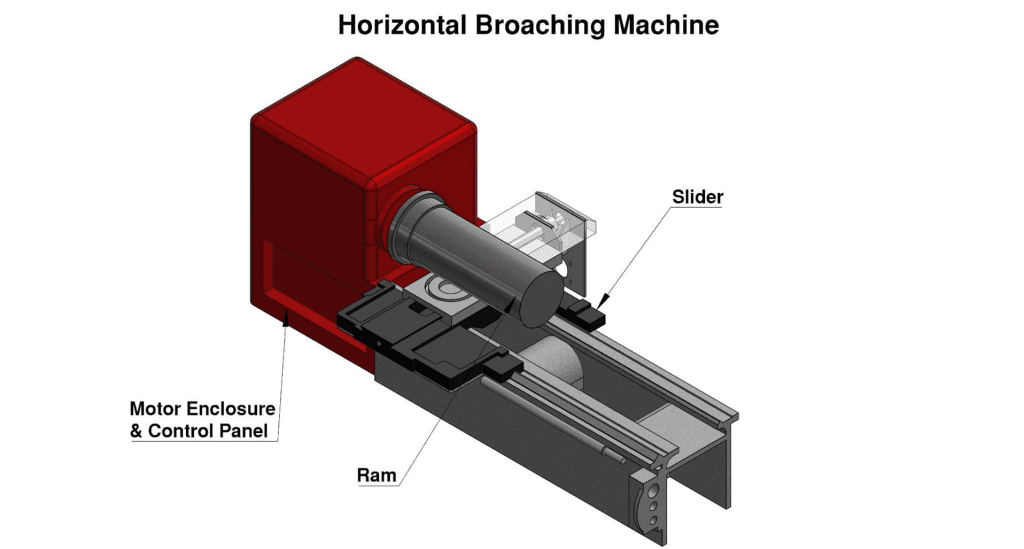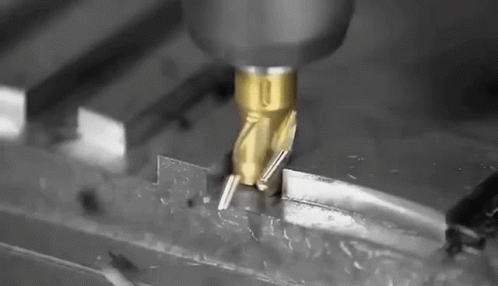
Broaching machining is a highly precise and efficient material removal process used in the manufacturing industry. This method employs a multi-tooth cutting tool called a broach, which removes material in a single pass, producing high-precision and superior surface finish components. The broaching process has become an essential part of various industries due to its speed, accuracy, and versatility.
Broaching Tools

Broaching tools are typically made from high-speed steel, carbide, or other durable materials that can withstand the high forces and stresses generated during the process. The design and geometry of broaching tools are critical in achieving the desired precision, accuracy, and surface finish. Each tooth on the broach is slightly larger than the preceding one, allowing for gradual material removal and a consistent final shape.
Proper maintenance and tool life management are essential for maximizing the efficiency and longevity of broaching tools. Regular inspection, sharpening, and replacement of worn tools can help maintain consistent cutting performance and minimize downtime.
The Process of Broaching
The broaching process involves pushing or pulling a broach through the workpiece, removing material in a continuous, single-pass motion. The broach features a series of progressively larger cutting teeth that gradually remove the material as it moves through the workpiece.
There are two primary types of broaching: internal and external. Internal broaching is used for creating precise internal shapes, such as holes, keyways, or splines, while external broaching is employed for shaping the external surfaces of a workpiece, such as gear teeth or specific profiles.
Broaching machines are designed to accommodate the broaching process, with components such as a workpiece holder, broach holder, and hydraulic or mechanical drive systems that provide the necessary force to push or pull the broach through the workpiece.

Workpiece material for broaching machining
Broaching is a versatile machining process suitable for a wide range of workpiece materials. The selection of the appropriate broaching tool material depends on the workpiece material and its properties. Some common workpiece materials that can be machined using broaching include:
| Workpiece Material | Broaching Tool Material | Notes/Considerations |
|---|---|---|
| Mild Steel | HSS, Carbide | Easy to machine, commonly used in manufacturing |
| Alloy Steels | HSS, Carbide | Depends on hardness; added elements like chromium, nickel, or molybdenum |
| Stainless Steel | Carbide | Harder grades require carbide tools due to work hardening and high strength |
| Cast Iron | HSS, Carbide (high-wear) | Carbide tools for harder grades or high-wear applications |
| Aluminum Alloys | HSS, Carbide, HSS with coating | Soft and lightweight, suitable for various tool types |
| Copper and Brass | HSS, Carbide | Soft, non-ferrous materials; carbide for improved tool life |
| Plastics and Composites | HSS | Sharp cutting edges and proper tool geometry to prevent chipping or melting |
| Titanium and Nickel-based Alloys | Carbide with coating, CBN | High strength, low thermal conductivity, and poor machinability; requires special tools |
HSS = High-Speed Steel, CBN = Cubic Boron Nitride
The choice of broaching tool material and geometry depends on the workpiece material’s hardness, toughness, and machinability. By selecting the appropriate tool, manufacturers can achieve efficient material removal, high precision, and excellent surface finish while machining various workpiece materials.
Advantages and Disadvantages of Broaching
Broaching offers several advantages, such as high precision and accuracy, superior surface finish, and efficient material removal. Its single-pass process allows for the rapid production of intricate shapes and profiles.
However, there are limitations and challenges associated with broaching, including high tool costs, reduced flexibility and longer setup times compared to other machining processes, and compatibility with specific workpiece materials and geometries.
Applications of Broaching Machining
Broaching is widely used in various applications and industries, such as gear broaching for manufacturing gears with complex tooth profiles, keyway and spline broaching for creating precise internal shapes, and surface broaching for shaping external features. Industries that frequently use broaching include automotive, aerospace, power generation, and manufacturing of machinery components. Here is a list of some common applications of broaching:
- Gear Broaching: Broaching is widely used to manufacture gears with various profiles, such as spur gears, helical gears, bevel gears, and internal or external splines. The process offers high precision and excellent surface finish, making it a popular choice for gear manufacturing.
- Keyway and Spline Broaching: Broaching is an efficient method for producing keyways and splines in components like shafts and couplings. It allows for the creation of accurate, straight, and parallel-sided slots in a single pass, ensuring a snug fit for the mating components.
- Surface Broaching: This application involves shaping or modifying the external surface of a workpiece. Examples include creating serrations, teeth, or grooves on a flat or curved surface. Surface broaching is commonly used in the automotive and aerospace industries for manufacturing engine components and structural parts.
- Internal Broaching: This method is used to create intricate internal profiles, such as holes, slots, or grooves, inside a workpiece. Examples include the manufacturing of gun barrels, hydraulic cylinders, and bushings. The process allows for the precise shaping of complex internal geometries with a superior surface finish.
- Blind Hole Broaching: Broaching can be used to create blind holes or features that do not pass completely through the workpiece. This application is common in industries such as aerospace, automotive, and heavy machinery, where components with unique internal geometries are required.
- Pot Broaching: This technique is used to create multiple features simultaneously on a workpiece, such as gear teeth and splines. The process involves passing the workpiece through a pot-shaped tool, which contains several broaching inserts arranged in a specific sequence. Pot broaching is commonly used in the automotive industry for manufacturing transmission components.
CNC Machining for Automotive Industry: Applications and Advantages
Broaching vs. Other Machining Processes
Each machining process has its unique advantages and limitations. Broaching excels in delivering high precision, superior surface finish, and efficient material removal for specific applications. However, it is essential to consider factors such as geometry, workpiece material, and production volume when selecting the most suitable machining process for your needs. Thus, it is essential to understand the differences between broaching and other machining processes to make informed decisions when selecting the best method for your manufacturing needs. This section provides a comparison between broaching and some common machining processes, including drilling, milling, and turning.
I. Broaching vs. Drilling
- Precision and Surface Finish:
- Broaching: Offers higher precision and a smoother surface finish.
- Drilling: Produces lower precision and may require additional finishing processes.
- Material Removal Rate:
- Broaching: Removes material efficiently, making it suitable for large-scale production.
- Drilling: Material removal rate is comparatively slower.
- Geometries and Features:
- Broaching: Can produce complex internal and external geometries, such as keyways, splines, and gear teeth.
- Drilling: Primarily used for creating cylindrical holes.
II. Broaching vs. Milling
- Precision and Surface Finish:
- Broaching: Provides superior precision and surface finish.
- Milling: Surface finish and precision may vary depending on the milling tool and technique used.
- Material Removal Rate:
- Broaching: Offers faster material removal for specific geometries.
- Milling: Can remove material at variable rates depending on the cutting tool and conditions.
- Geometries and Features:
- Broaching: Limited to linear profiles and features.
- Milling: Can produce a wide range of geometries, including 3D contours and complex profiles.
III. Broaching vs. Turning
- Precision and Surface Finish:
- Broaching: Delivers high precision and an excellent surface finish.
- Turning: May require additional finishing processes for intricate geometries.
- Material Removal Rate:
- Broaching: Efficiently removes material for specific features and profiles.
- Turning: Typically offers a high material removal rate for cylindrical workpieces.
- Geometries and Features:
- Broaching: Suitable for both internal and external geometries, including splines, keyways, and gear teeth.
- Turning: Primarily used for producing cylindrical and conical shapes, with limited capacity for internal features.
Conclusion
Broaching machining has become an indispensable part of the manufacturing industry due to its high precision, accuracy, and efficiency in material removal. By understanding the process, applications, and advantages of broaching, manufacturers can optimize their production processes and improve the quality of their products. While broaching has its limitations and challenges, its unique capabilities make it an invaluable tool in various industries and applications.
ProLeanTech is a leading provider of broaching machining services, offering cutting-edge solutions tailored to your manufacturing needs. By leveraging the advantages of broaching, our team of skilled professionals delivers exceptional precision and quality in every project.
Our Broaching Machining Service Advantages:
- High Precision and Accuracy: At ProLeanTech, we understand the importance of precision and accuracy in manufacturing. Our broaching services ensure the highest level of dimensional accuracy, meeting even the most stringent industry standards.
- Superior Surface Finish: Our broaching expertise guarantees a smooth, burr-free surface finish, reducing the need for additional finishing processes and minimizing production costs.
- Efficient Material Removal: ProLeanTech’s broaching services allow for rapid material removal and shorter cycle times, leading to increased productivity and reduced lead times.
- Versatility: Our team has experience working with a wide range of workpiece materials and geometries, making our broaching services suitable for various industries and applications.
- Customized Solutions: At ProLeanTech, we understand that every project is unique. Our team works closely with clients to develop custom broaching solutions that meet their specific requirements and exceed expectations.
By choosing ProLeanTech’s broaching machining services, you can trust our commitment to delivering exceptional results, backed by our dedication to customer satisfaction and continuous improvement. Contact us to learn more about our services and start your journey toward manufacturing excellence today!
Frequently Asked Questions
What is an example of broaching?
A. An example of broaching is manufacturing gears with complex tooth profiles or creating keyways and splines in shafts.
How is broaching different from drilling?
A. Broaching is different from drilling in that it can create complex shapes and profiles with high precision, while drilling is primarily used for making round holes.
What is the best alternative to broaching?
A. The best alternative to broaching depends on the specific application but may include wire EDM, grinding, or laser cutting.
What is the commonly used material for broaching?
A. High-speed steel and carbide are commonly used materials for broaching tools.
What is the most used type of broaching?
A. Internal broaching is the most used type of broaching, as it is ideal for creating precise internal shapes like holes, keyways, and splines.




0 Comments